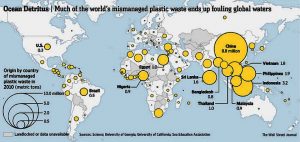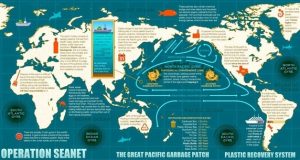Microplastics in Bottled Water – New Study
Study Summary:
- “Tests reveal bottled water contains nearly twice as many microplastic particles per liter as tap water. The contamination is thought to originate from the manufacturing process of the bottles and caps
- Researchers tested 259 bottles of 11 popular bottled water brands for the presence of microscopic plastic. On average, the bottled water tested contained 325 pieces of microplastic per liter
- Only 17 of 259 bottles were found to be free of microplastic particles (5 mm and 0.003 mm), and none of the brands tested consistently free of plastic contaminants. The worst offender was Nestlé Pure Life, the most contaminated sample of which contained 10,390 particles per liter
- In response to these findings, the World Health Organization has vowed to launch a safety review to assess the potential short- and long-term health risks of consuming microplastic in water
- A report by the U.K. Government Office for Science warns plastic debris littering the world’s oceans — 70 percent of which does not biodegrade — is likely to triple by 2025 unless radical steps are taken to curb pollution.”
We recommend the following:
- Get Your Drinking Water Tested you must Know Your H20.
- Read our article on Plastics.
- Consider treating your existing tapwater .
- Microplastic Testing of Your Drinking Water.
NSF Intl. has developed a test method and protocol to verify a water treatment device’s ability to reduce perfluorooctanoic acid (PFOA) and perfluorooctane sulfonate (PFOS) to below the health advisory levels set by the U.S. Environmental Protection Agency (EPA).
[amazon_textlink asin=’B06XGZMTRH’ text=’P473: Drinking Water Treatment Units – PFOA and PFOS’ template=’ProductLink’ store=’webdespro-20′ marketplace=’US’ link_id=’b50a0a69-0f13-11e9-bbe7-ebfc03ac31a1′]
Plastics – Stop Littering – We need to make a change !
by S. Oram (new blogger)
Where do you throw your plastics and trash when you are done with it? I would hope you say you RECYCLE ! Because just throwing that container away by mixing it with the normal trash or discarding out the window creates problems. Part of this problem is POLLUTION. This pollution creates visual aesthetic issues, but also damages habitat and threatens the land, air, and sea animals. Did you ever stop and think about how these things can affect the animals outside? Most plastic waste comes from third world countries especially in China, but we can still make a difference.
 https://goo.gl/images/38xfsv Online Source –
https://goo.gl/images/38xfsv Online Source –
In the 1970s, the National Academy of Sciences estimated about 45,000 tons of garbage and waste was being tossed and thrown in the ocean. Since initial estimate, it has gotten even worse. Many people throw things in the ocean and don’t think about the animals in it or the other uses downstream. The materials can get wrapped around the animals or some of the animals eat. The animals become hurt, sick, and die. Littering can kill marine life and destroy habits. Some people don’t stop to think about the animals and their safety. Over 100,000 marine mammals and 1 million sea birds are killed each year from plastic pollution and 6 million tons of debris, i.e., a ton is 200 lbs , enters the ocean each year. It is time to say – Enough!

Sad there is no reason to create this type of pain and suffering.
Did you know it can take up to 450 years for plastic bottles to decompose?
Where is most of this plastic? (Operation Seanet)
Here is a list of wastes that go in the ocean and how long it takes to decompose.
Foam cups and tin cans – up to 50 years.
Plastic bottles up to 450 years.
Fine fishing net up to 600 years (much longer for heavier nets).
Cigarette butts- 1 – 5 years.
Plastic bags- 10 – 20 years (Some putting this debris in a plastic bag is not good enough) . The bags breakdown and this it may take 100s of years for the content to decompose.
[amazon_link asins=’163220665X’ template=’ProductAd’ store=’webdespro-20′ marketplace=’US’ link_id=’8b146ff4-ef1a-11e7-bbda-f1d33eb90426′]
SO – Simply Bagging the Trash is Not a Solution. We must make every effort to recycle, reuse, and then put our young minds together and help to clean up our oceans, beaches, and landscapes and develop better solutions.
My call to action:
- Please think twice before littering and think twice before throwing stuff away.
- Pick up litter and Recycle – Participate in local clean up events.
- Try to kick the plastic habit.
- Check out Operation – Seanet
Sources:
http://www.perseus-net.eu/site/content.php?locale=1&sel=517&artid=565
https://www.dpaw.wa.gov.au/management/marine/marine-parks-wa
http://www.bluebird-electric.net/oceanography/Ocean_Plastic_International_Rescue/Logistics_Recycling_Plastic_Ocean_Cleanup_Cargo_Operations.htm

